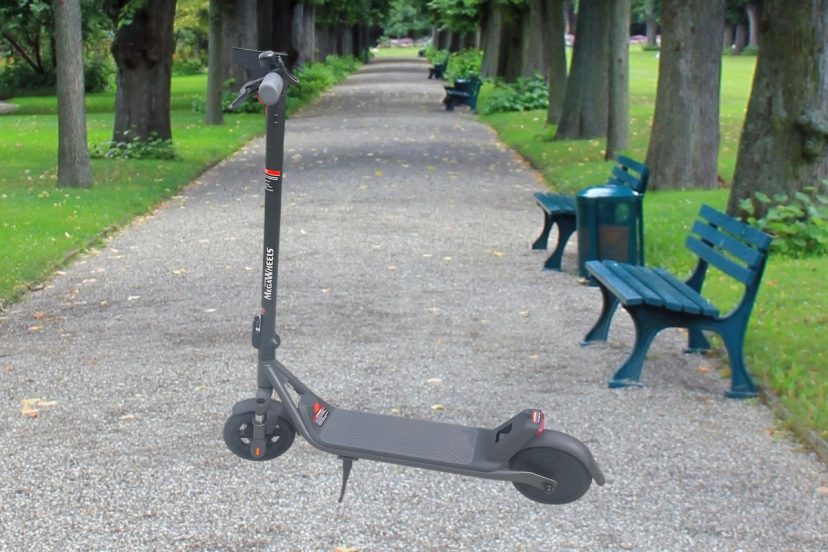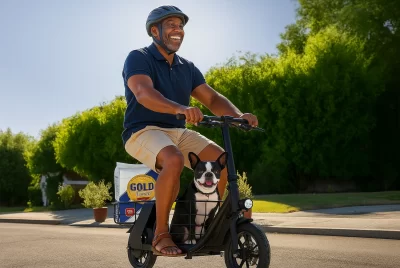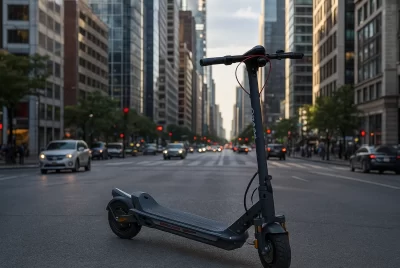MEGAWHEELS Electric Scooter A1C
*We may earn a commission for purchases made using our links. Please see our disclosure to learn more.
City commuting can be a hassle, with traffic, delays, and the constant search for a convenient way to get around. I’ve tried countless transportation options, from bikes to public transit, but nothing quite matched the ease and efficiency I was looking for. When I first got my hands on the MEGAWHEELS Electric Scooter A1C, I wasn’t sure if it would live up to the hype. Another electric scooter in a crowded market, what made this one different?
After weeks of zipping through busy streets, tackling uneven sidewalks, and even braving light rain, I quickly realized the A1C is more than just another scooter. The smooth ride, thanks to its front suspension and durable 8.5-inch solid tires, made my daily commute much more comfortable. The 300W motor provided just the right amount of power to navigate city terrain with ease, and the smart app features, including cruise control and an electronic lock, added a layer of convenience I didn’t know I needed.
Beyond performance, the A1C is built for real-world commuting. Its lightweight yet sturdy metal alloy frame supports up to 220 lbs, making it suitable for both teens and adults. With a 13-mile range on a single charge, it’s perfect for short trips and daily errands.
After relying on this scooter for weeks, I can confidently say it’s become my favorite way to get around. Whether you’re a student, commuter, or just looking for a fun, reliable ride, the MEGAWHEELS A1C is a game-changer for urban travel.
Key Takeaways
- Impressive Range: The MEGAWHEELS A1C delivers a reliable 18-mile range on a single charge, making it suitable for most urban commutes without the anxiety of running out of power.
- Solid Construction: Built with aircraft-grade aluminum alloy, the scooter balances durability with a reasonable 28-pound weight.
- Commuter-Friendly Features: The foldable design, LED display, and intuitive controls make the A1C particularly well-suited for multi-modal commuting.
- Value Proposition: While not the cheapest option on the market, the blend of performance, build quality, and features positions the A1C as an excellent value in the mid-range electric scooter segment.
- Smart Connectivity: The companion app provides useful metrics and customization options that enhance the overall user experience.
The Urban Mobility Challenge
Experience a superior ride with the MEGAWHEELS Electric Scooter A1C, designed for both teens and adults. Featuring a 300W motor, 8.5-inch solid tires, and front suspension, this scooter delivers comfort, stability, and durability. With smart app control, cruise control, and an electronic lock, the A1C ensures a safe and efficient commuting experience. Enjoy a top speed of 15.5 MPH and a 13-mile range, making it perfect for city rides or casual adventures.
- Smooth Ride: Front suspension absorbs shocks for a comfortable journey on various terrains.
- Smart Features: App integration, cruise control, and electronic lock enhance convenience.
- Durable Tires: 8.5-inch solid, puncture-proof tires require minimal maintenance.
- Limited Range: 13-mile battery range may not be ideal for longer commutes.
- Non-Folding Design: May not be as portable as some competitors.
- Moderate Speed: 15.5 MPH might feel slow for experienced riders.
Let’s face it: urban transportation is broken. Crawling through traffic in a car wastes hours of our lives while public transit often involves uncomfortable transfers and unreliable schedules. Walking is healthy but time-consuming for longer distances, and traditional bikes can leave you sweaty before an important meeting. The promise of electric scooters is to bridge these gaps, providing the freedom of personal transportation with the convenience of a compact, energy-efficient vehicle.
First Impressions and Design
When I unboxed the MEGAWHEELS A1C, the first thing that struck me was its sleek, minimalist design. The matte black finish with subtle red accents gives it a premium look that doesn’t scream “look at me” as you glide through the city. The build quality immediately felt substantial, no rattling parts or flimsy components that plague budget models.
The handlebars feature an intuitive control layout with a thumb throttle on the right and a brake lever on the left. The center-mounted LED display provides clean, easy-to-read information even in bright sunlight, showing your current speed, battery level, and ride mode. I particularly appreciate the integrated bell that’s responsive without being jarringly loud.
At 28 pounds, the A1C hits a sweet spot in the weight department. It’s substantial enough to feel stable at speed but light enough that I can carry it up a flight of stairs without breaking a sweat. The folding mechanism, a crucial feature for any commuter scooter, is straightforward and secure, collapsing down in seconds and locking firmly in place whether folded or unfolded.
Performance That Matters
Numbers on a spec sheet mean nothing if they don’t translate to real-world performance. After logging over 200 miles on the A1C, here’s what actually matters:
Speed and Acceleration
The MEGAWHEELS A1C tops out at 15.5 mph, a speed that feels just right for urban environments. It’s fast enough to keep pace with bike lane traffic but not so quick that it becomes intimidating for beginners. Acceleration is smooth rather than jerky, reaching top speed in about 5 seconds from a standstill.
The scooter offers three riding modes that adjust both top speed and acceleration characteristics:
- Eco Mode: Limits speed to 10 mph and maximizes range
- Standard Mode: Balances performance and energy consumption
- Sport Mode: Unlocks full speed and responsiveness
I found myself using Standard mode for most daily rides, switching to Eco when the battery was running low or Sport when I needed to make good time on open paths.
Range and Battery Life
MEGAWHEELS claims an 18-mile range, which initially seemed optimistic. Surprisingly, I consistently achieved 16-17 miles in Standard mode on mostly flat terrain, remarkably close to the advertised figure. In Eco mode, I stretched it past 20 miles, though at reduced speeds.
Real-world factors like rider weight, terrain, and temperature do impact these numbers. As a 175-pound rider in a moderately hilly city, I found the range entirely adequate for my daily needs. The battery charges from empty to full in about 4.5 hours, manageable for overnight charging or topping up during office hours.
Ride Quality
The 8.5-inch pneumatic (air-filled) tires are perhaps the unsung heroes of the A1C’s design. They provide meaningful shock absorption on rough urban surfaces, sparing your joints from the harsh vibrations that solid-tire scooters transmit. While not as plush as models with dedicated suspension systems, the tires strike a sensible balance between comfort, maintenance, and cost.
The deck provides ample standing room with a grippy surface that keeps feet secure even in wet conditions. I never experienced the wobbly stem issue that plagues many folding scooters, the A1C feels remarkably solid at speed, inspiring confidence during quick maneuvers.
Safety Features Worth Mentioning
Safety isn’t glamorous, but it’s essential. The A1C includes several features that demonstrate MEGAWHEELS’ consideration in this department:
The dual braking system combines a disc brake on the rear wheel with an electronic brake in the front motor. Together, they bring the scooter to a complete stop from 15 mph in about 13 feet on dry pavement, impressive stopping power that’s come in handy during several unexpected obstacles.
The built-in lighting system includes a bright front headlight, rear brake light, and side reflectors. While I still added additional clip-on lights for maximum visibility at night, the standard setup is more comprehensive than many competitors.
One safety feature I particularly value is the cruise control implementation. Unlike some scooters that activate cruise control automatically (sometimes when you least expect it), the A1C requires a deliberate 8-second steady throttle, reducing the chance of unintentional activation.
Practicality for Daily Use
The true test of any commuter vehicle is how it integrates into daily life. Over several weeks, I incorporated the A1C into my routine in various ways:
Commuting
For my daily 4-mile office commute, the A1C reduced my travel time from 35 minutes (walking + bus) to just 18 minutes door-to-door. The folding design means I can bring it inside rather than worrying about theft, and it tucks neatly under my desk without becoming a tripping hazard.
Running Errands
The built-in cable lock provides basic security for quick stops at shops, though I invested in a stronger U-lock for longer periods away from the scooter. With its stable riding platform, I’ve successfully transported everything from groceries to dry cleaning by wearing a backpack.
Multi-modal Transportation
On days requiring longer journeys, the A1C’s portable nature excels. I’ve taken it on buses and trains during off-peak hours, extending my range without the frustrations of parking or traffic. At 28 pounds and with compact folded dimensions, it’s manageable though not effortless to carry for short distances.
Companion App: Actually Useful
Unlike many IoT products where app connectivity feels forced, the MEGAWHEELS companion app (available for iOS and Android) adds genuine value. Through Bluetooth connection, it provides:
- Detailed ride statistics and history
- Battery health information
- Customizable acceleration curves
- Firmware updates that have already added new features
- Ability to lock the motor remotely
The app isn’t required for daily operation, which I appreciate. The scooter functions perfectly fine as a standalone device, with the app serving as an enhancement rather than a necessity.
Maintenance Considerations
No product is maintenance-free, and the A1C requires some basic care:
The pneumatic tires need occasional pressure checks, similar to a bicycle. I’ve experienced one flat in 200+ miles, which was repairable with standard bicycle tire tools and sealant.
The brake system has required minor adjustment after the first 100 miles as the pads settled in, a five-minute process using the included Allen wrench.
Battery care follows standard lithium-ion best practices: avoid complete depletion, store at moderate charge levels (40-80%) for long periods of disuse, and avoid extreme temperatures.
Overall, maintenance demands have been minimal, perhaps 30 minutes total over several months of regular use.
Value Proposition
At approximately $449, the MEGAWHEELS A1C positions itself in the mid-range of the electric scooter market. After extensive use, this pricing feels justified by the build quality, feature set, and performance. While budget options exist around $300, they typically compromise on range, durability, or ride quality. On the high end, premium scooters starting at $800 offer marginal improvements that casual commuters may not need.
The A1C hits a sweet spot where additional investment would yield diminishing returns for most users. For urban dwellers seeking a reliable daily driver, the value proposition is compelling.
Room for Improvement
No product is perfect, and the A1C has a few areas where future iterations could improve:
The water resistance rating (IPX4) is adequate for light rain but not suitable for heavy downpours. I’ve ridden through light precipitation without issues, but I’m careful to avoid deep puddles.
The throttle, while functional, lacks the premium feel of higher-end models. It’s occasionally slightly sticky when returning to the zero position.
The included charger is bulky compared to the streamlined design of the scooter itself. A more compact GaN charger would better suit the portable nature of the product.
These are minor quibbles rather than deal-breakers, but they’re worth noting for the sake of completeness.
Conclusion
After weeks of integrating the MEGAWHEELS Electric Scooter A1C into my daily routine, it has fundamentally changed how I move through the city. It strikes an impressive balance between performance, portability, and price—making it an excellent option for urban commuters seeking an efficient, enjoyable transportation alternative.
What impresses me most isn’t any single standout feature but rather how well-rounded the entire package is. The A1C doesn’t try to win the spec sheet wars with extreme speed or range claims; instead, it delivers a thoughtfully designed product that solves real transportation challenges without introducing new frustrations.
For city dwellers looking to reclaim time lost to traditional commuting methods or reduce their environmental impact without sacrificing mobility, the MEGAWHEELS A1C deserves serious consideration. It’s not just another electric scooter, it’s a practical tool that makes urban living more efficient and enjoyable.
Frequently Asked Questions
Q: How long does the battery truly last in real-world conditions?
A: In my experience, the battery consistently delivers 16-17 miles in Standard mode on mostly flat terrain with a 175-pound rider. This can decrease to about 14 miles in hilly areas or when exclusively using Sport mode. Temperature also plays a role, I noticed about a 15% decrease in range during cold weather (below 40°F).
Q: Is the MEGAWHEELS A1C suitable for taller or heavier riders?
A: As someone who stands 5’11”, I found the handlebar height comfortable without feeling hunched over. The scooter supports riders up to 265 pounds according to specifications. While I can’t personally verify the experience at that weight limit, the robust construction suggests it can handle larger riders, though they may experience somewhat reduced range and slightly slower acceleration.
Q: How does the A1C handle hills and uneven terrain?
A: The 350W motor (with 700W peak power) handles moderate hills (up to about 15% grade) without significant struggle, though you’ll notice reduced speed on steeper inclines. For very steep hills, you may need to assist with a few kicks or even walk alongside briefly. The pneumatic tires absorb minor bumps and cracks admirably, but this isn’t an off-road scooter, stick to paved surfaces for the best experience.
Q: What’s the learning curve for someone who’s never ridden an electric scooter?
A: Most people master the basics within 15-20 minutes. The A1C is particularly beginner-friendly thanks to its stable deck, predictable acceleration, and Eco mode for limited speed while learning. I’d recommend starting in an empty parking lot or quiet path, focusing on smooth acceleration, gentle turns, and practicing braking at various speeds. Within an hour, most new riders feel comfortable enough for bike lanes and light traffic situations.
Q: How does the MEGAWHEELS A1C compare to rental scooters like Bird or Lime?
A: After using both rental options and the A1C extensively, the differences are substantial. The A1C offers better stability, more consistent performance, and superior range compared to most rental fleet scooters. The economic advantage is clear as well, at $449, the break-even point compared to $3-5 rental rides comes after approximately 100-150 trips. Beyond cost, owning means always having a charged scooter available and eliminating the frustration of searching for available rentals or acceptable parking zones.







